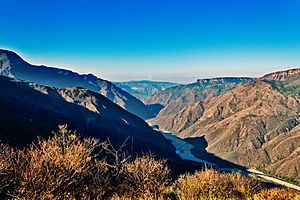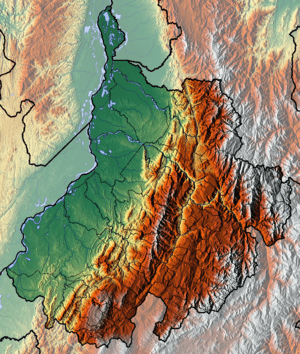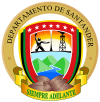Santander Department facts for kids
Quick facts for kids
Department of Santander
Departamento de Santander
|
|||
|---|---|---|---|

|
|||
|
|||
| Motto(s):
Santandereanos siempre adelante
(Spanish: People of Santander always ahead) |
|||
| Anthem: Himno de Santander | |||

Santander shown in red
|
|||

Topography of the department
|
|||
| Country | |||
| Region | Andean Region | ||
| Established | May 13, 1857 | ||
| Capital | Bucaramanga | ||
| Largest city | Bucaramanga | ||
| Area | |||
| • Total | 30,537 km2 (11,790 sq mi) | ||
| Area rank | 12th | ||
| Population | |||
| • Total | 2,184,837 | ||
| • Rank | 6th | ||
| • Density | 71.5472/km2 (185.3064/sq mi) | ||
| GDP | |||
| • Total | COP 92,277 billion (US$ 21.7 billion) |
||
| Time zone | UTC-05 | ||
| ISO 3166 code | CO-SAN | ||
| Provinces | 8 | ||
| Municipalities | 87 | ||
| HDI | 0.768 high · 8th of 33 |
||
| Website | gobernaciondesantander.gov.co | ||
Santander is a special region, or department, in Colombia. It's located in the central northern part of the country. Santander got its name from one of the nine original states of the United States of Colombia.
This department shares borders with the Magdalena River to the east. It also borders Boyacá to the south and southeast. To the northeast, you'll find the Norte de Santander Department. The Cesar Department is to the north, and the Bolivar and Antioquia Departments are to the west. The capital city of Santander is Bucaramanga.
Contents
History of Santander
Early People of Santander
Before the Spaniards arrived, many different groups of Amerindian people lived in the area now called Santander. These groups included the Muisca, Chitareros, Laches, Yariguí, Opón, Carare, and Guanes.
These groups had their own ways of organizing their communities. They often lived in cacicazgos, which were like groups of tribes led by a main chief called a cacique. People had different roles in their society.
Their main job was farming. They grew many important crops like maize (corn), beans, yuca, arracacha, cotton, and tobacco. They also grew fruits like tomatoes, pineapples, and guavas. They were very skilled farmers and knew how to grow food on different types of land, even in the mountains. For example, the Guanes built terraces (flat steps on hillsides) and used special systems to bring water to their crops.
They were also good at arts and crafts. They made pottery using ovens. They used cotton to make clothes, hats, and bags.
Spanish Arrival and Settlement
The first Spanish explorer to travel through this area was Antonio de Lebrija in 1529. Later, around 1532, a German explorer named Ambrosius Ehinger came looking for a legendary golden city called El Dorado. His arrival caused a lot of trouble for the Amerindian villages.
Some groups, like the Yariguíes, Opones, and Carares, fought against the explorers until they sadly disappeared. Another explorer, Gonzalo Jiménez de Quesada, later visited the area to try and make peace with the tribes.
The Spanish began to settle the area. Martín Galeano founded the village of Vélez on July 3, 1539. Later, Pedro de Ursúa and Ortún Velázquez de Velasco founded Pamplona in 1549. Pamplona is now part of the Norte de Santander Department.
After the Amerindian tribes were under Spanish control, the Spanish set up local governments called Cabildos (councils). These councils helped them rule the land and keep order. The Amerindian people were made to work in farming, making goods, and in mines. This system was called the encomienda regime.
The villages of Vélez and Pamplona became important centers for these councils. In 1636, the council of Vélez moved its main area to a new village called Girón. This new area stretched from the Sogamoso River to the Magdalena River.
Later, in 1689, the village of San Gil was created, separating from the Vélez area. In 1789, Socorro was also separated from Vélez. All these areas were then put under the control of the Province of Tunja.
On July 9, 1795, a new local government was created for Vélez, San Gil, and Socorro. This new government was based in Socorro.
Culture of Santander
The culture of Santander is a special mix of Spanish and Chibcha influences. This is especially true in the south, where the Muisca people lived, and in the Chicamocha Canyon, where the Guane were located.
During the time of the Spanish colony and the war for independence, people from Santander were known for being very brave in battle. They had a strong spirit and a saying: "not even a step back." Soldiers from Santander were respected for their courage. They were also known for being politically aware, which meant they often questioned orders and laws.
One of the most famous artists from Santander is Oscar Rodríguez Naranjo.
Notable People from Santander
Many important people have come from Santander:
- Manuela Beltrán (born 1724) was a woman from the Viceroyalty of New Granada who led a protest against high taxes in 1780.
- María Antonia Santos Plata (1782–1819) was a brave leader and hero from Pinchote who fought for independence.
- Geo von Lengerke (1827−1882) was a German engineer and businessman who owned land in the region.
- Ofelia Uribe de Acosta (1900–1988) from Oiba was a strong supporter of women's right to vote.
- Oscar Rodríguez Naranjo (1907–2006) was a famous painter.
- José de Jesús Pimiento Rodríguez (1919–2019) from Zapatoca was a high-ranking leader in the Catholic Church.
- Virginia Gutiérrez de Pineda (1921–1999) from El Socorro was an anthropologist. She was a pioneer in studying Colombian families and medical traditions.
- Reiner Bredemeyer (1929–1995) from Vélez, Santander was a German composer.
- Carlos Ardila Lülle (1930–2021) was a successful businessman born in Bucaramanga. He founded a large company called Organización Ardila Lülle.
- Carlos Prada Sanmiguel (1939–2013) was a Roman Catholic bishop.
- Patricia Ariza (born 1948) from Vélez, Santander is a poet, writer of plays, and actor.
Santander's Divisions
Provinces in Santander
The Santander department is divided into smaller areas called provinces:
- Metropolitana Province
- North Soto Province
- Comunera Province
- Guanentá Province
- Vélez Province
- García Rovira Province
- Mares Province
- Carare-Opón Province
Cities and Towns (Municipalities)
Santander also has many cities and towns, which are called municipalities:
- Aguada
- Albania
- Aratoca
- Barbosa
- Barichara
- Barrancabermeja
- Betulia
- Bolívar
- Bucaramanga
- Cabrera
- California
- Capitanejo
- Carcasí
- Cepitá
- Cerrito
- Charalá
- Charta
- Chima
- Chipatá
- Cimitarra
- Concepción
- Confines
- Contratación
- Coromoro
- Curití
- El Carmen
- El Guacamayo
- El Peñón
- El Playón
- Encino
- Enciso
- Florián
- Floridablanca
- Galán
- Gámbita
- Girón
- Guaca
- Guadalupe
- Guapotá
- Guavatá
- Güepsa
- Hato
- Jesús María
- Jordán
- La Belleza
- Landázuri
- La Paz
- Lebrija
- Los Santos
- Macaravita
- Málaga
- Matanza
- Mogotes
- Molagavita
- Ocamonte
- Oiba
- Onzaga
- Palmar
- Palmas del Socorro
- Páramo
- Piedecuesta
- Pinchote
- Puente Nacional
- Puerto Parra
- Puerto Wilches
- Rionegro
- Sabana de Torres
- San Andrés
- San Benito
- San Gil
- San Joaquín
- San José de Miranda
- San Miguel
- Santa Bárbara
- Santa Helena del Opón
- San Vicente de Chucurí
- Simacota
- Socorro
- Suaita
- Sucre
- Suratá
- Tona
- Valle de San José
- Vélez
- Vetas
- Villanueva
- Zapatoca
See also
 In Spanish: Santander (Colombia) para niños
In Spanish: Santander (Colombia) para niños




